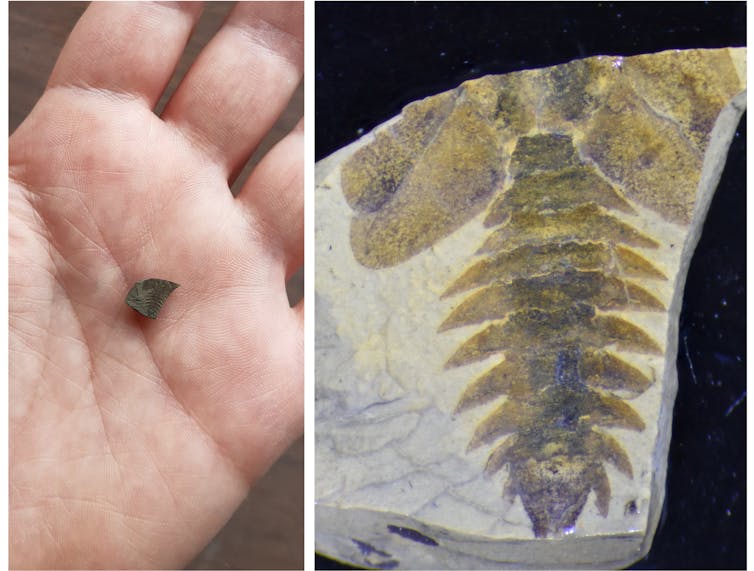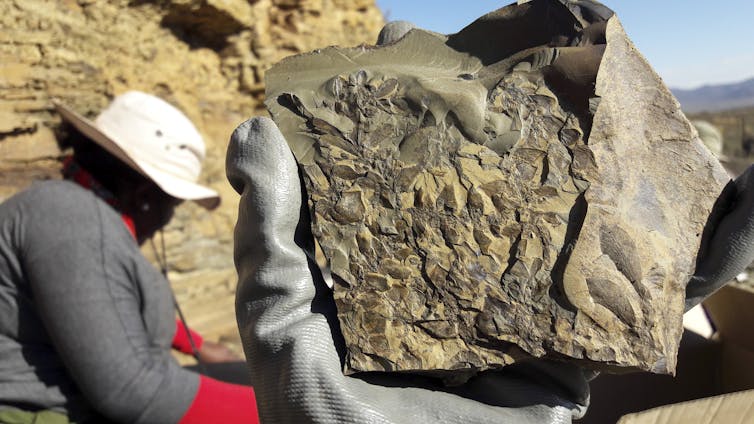![A fossilised insect wing with some of its colouration preserved is just one tiny treasure emerging from the site. [CREDIT: Rose Prevec]](/media/rhodesuniversity/content/rhodesnews/newsimage/FossilsWeb.webp)
By , Palaeontologist, Rhodes 老虎机游戏_pt老虎机-平台*官网
South Africa is famous for its amazingly rich and diverse fossil record. The country’s rocks document more than 3.5 billion years of life on Earth: ancient forms of bacterial life, the emergence of life onto land, the evolution of seed-producing plants, reptiles, dinosaurs and mammals – and humanity.
Many will be familiar with hominid fossils such as the Australopithecus africanus skull Mrs (or is it Mr?) Ples and the paradigm-shifting Taung child. Less well known and equally important fossils such as the oldest terrestrial vertebrates in the ancient supercontinent Gondwana, which document the first steps from the ocean and onto land, have also emerged from South Africa. The country’s wealth of fossils is due in part to the region’s unique geology, which documents 100 million years of nearly continuous deposition in its Karoo Basin.
Fossils also hold clues to climatic shifts, from the great Carboniferous ice age over 300 million years ago, to the huge dunes of blazing Jurassic deserts where dinosaurs roamed 200 million years ago. Scientists can read the devastation of the mass extinction events that destroyed global ecosystems and changed the course of Earth’s history.
But in the race to understand the “big picture” of the evolution of life and to distil its dramatic ups and downs into punchy headlines, it is easy to forget the small and quiet things. Pause, and consider what life looked like on an average day, in a world without humans, mammals, birds, butterflies, flowers, or even dinosaurs. What was it like on the shores of a rippling lake, on a drowsy summer afternoon, 266 million years ago in what’s now the Northern Cape province of South Africa?
The search, and what we found
In a new paper, my colleagues and I provide the first glimpse of such an ecosystem. We have found a profusion of fossils of tiny insects that have never been found before, as well as important plant specimens that are changing our understanding of how they evolved.
Our findings give fresh insights into the effects of extinction events on ecosystems. The subject has taken on great urgency in the face of what scientists are calling the sixth great extinction event, which is being driven by the current trend of global warming.
For the past few years we have been excavating a small, nondescript rock outcrop near Sutherland in the Northern Cape.
This outcrop is yielding untold fossil treasures of plants, insects and other invertebrates that are new to science. These unique fossils, some only a few millimetres long, are telling us about what lived in and around a calm pool on a delta plain during the middle Permian period between 266 million and 268 million years ago. Rocks of this age contain fossils of the oldest therapsids, a group of reptiles that eventually gave rise to the mammals.
Other life of this time included the lizard-like ancestors of tortoises, large amphibians that lurked like crocodiles just below the water surface, and forests dominated by a tree called Glossopteris with an understorey of spore-producing plants such as mosses, ferns and horsetails.
Teams of palaeontologists have discovered and excavated many hundreds of vertebrate fossils in the western and southern Karoo of South Africa that date back to the Permian, including the Sutherland District and surrounding areas. But the kinds of rocks that are rich in vertebrate fossil bones tend not to preserve plants and invertebrates. These seem to require the more anoxic, acidic conditions present in calm lakes and pools for high fidelity preservation, whereas bones preserve well in more oxygen-rich settings.
This makes it difficult to understand the ecosystems of this time – and means our discoveries are especially astonishing. These include the oldest freshwater leech, a record that pushes back the known range of this group by 40 million years, and the oldest water mites by 166 million years.
Other exciting finds include the oldest damsel-fly and oldest stoneflies from Gondwana, as well as a profusion of the tiny, aquatic, immature stages (nymphs) of an extinct group called the Palaeodictyoptera. Many of the insect wings we have found have yet to be identified.

There are also mosses and liverworts, tiny soft plants that were among the first to colonise land. They too, have a very poor fossil record, and we have found both at our site. The liverwort is the oldest in Africa and one of only a few records for the Permian period globally.
One of the most exciting finds is the dense accumulations of the male and female cones of the Glossopteris plant, an unbelievably rare occurrence that is shedding light on the evolution and classification of this important coal-forming plant.

Great potential
Our work has been slow. Excavations have involved a lot of sitting on spiky rocks in the sun for weeks on end, extracting tiny pieces of mudrock and then examining them with a magnifying hand lens.
The fossil site is still producing new weird and wonderful plants and invertebrates, and will keep us busy for a while. There is also great potential for finding other sites in the region. The thousands of plants and insects we have collected so far are being carefully curated and studied at the Albany Museum in Makhanda. We are keenly aware of the need to conserve this precious part of South Africa’s protected natural heritage.
Our work to better understand the organisms we’re finding provides knowledge about how and when they evolved and interacted as well as about local climate, how their distributions changed through time, how the positions of the continents changed, and the effects of deserts, mountain ranges and seas on the movement and evolution of life.
This is very important when trying to understand extinction events such as the Great Dying, which marked the end of the Permian 252 million years ago. It destroyed most life in the oceans and on land and – in a chilling echo of the current global climate crisis – was driven by hundreds of thousands of years of volcanic activity that produced huge amounts of greenhouse gases, leading to an increase in global temperatures.
Original article: https://theconversation.com/exquisite-new-fossils-from-south-africa-offer-a-glimpse-into-a-thriving-ecosystem-266-million-years-ago-194263
